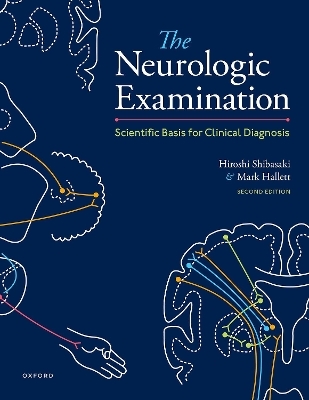
The Neurologic Examination
Oxford University Press Inc (Verlag)
978-0-19-755630-6 (ISBN)
The second edition of The Neurologic Examination looks at how to conduct a clinical neurological examination through a pathophysiological approach to the nervous system. This new edition is brought up to date with new data on genetic and immunological disorders and a significant expansion of illustrations of skin manifestations of neurologic disorders.
The book provides in-depth instructions for clinicians with a logical order of history and the different parts of the examination. Organized by the functional anatomy of the nervous system, the book provides a bridge from basic science to symptoms and signs of many common and rare neurologic disorders, which will help in making diagnoses. The authors look at how to carry out an examination in different circumstances, from outpatients to patients in respiratory distress, with stroke and epilepsy, and various states of consciousness including coma. Laboratory testing is recommended when appropriate, but the main emphasis is on history and physical examination.
The book contains over a hundred discussion boxes with details about neurologic disorders and history. While mainly directed to students and residents learning how to do a neurologic examination, it will still be useful even for more experienced clinicians.
Professor Hiroshi Shibasaki trained at Kyushu University Graduate School of Medicine, University of Minnesota, and the Institute of Neurology, Queen Square. He was Director of Human Brain Research Center (1990-2003) and Chairman of Neurology (1999-2003) at Kyoto University Graduate School of Medicine, Japan. He was Fogarty Scholar at NINDS, NIH, USA (2003 to 2005) and President of International Federation of Clinical Neurophysiology (2007-2010). Professor Shibasaki made many contributions to clinical neurophysiology and movement disorders and has been well known as an outstanding teacher. Professor Mark Hallett trained at Harvard Medical School, the National Institutes of Health, and the Institute of Psychiatry, London. He was at Harvard Medical School (1976-1984), and since then he has been Chief, Human Motor Control Section, NINDS, NIH. He has been President of the Movement Disorder Society, the American Association of Neuromuscular and Electrodiagnostic Medicine, the International Federation of Clinical Neurophysiology, and the Functional Neurological Disorder Society. He was Editor in Chief of Clinical Neurophysiology. He has trained many fellows from all over the world and made important contributions to the principles of human motor control and its disorders.
List of Boxes
Preface to the First Edition
Preface to the Second Edition
Explanatory Notes
Acknowledgements
Chapter 1: Diagnosis of Neurological Diseases
Chapter 2: History Taking
Chapter 3: Physical Examination
Chapter 4: Evaluation of Consciousness
Chapter 5: Brainstem and Cranial Nerve Territories
Chapter 6: Olfactory Sensation
Chapter 7: Visual Functions
Chapter 8: Pupils and Accommodation
Chapter 9: Extraocular Muscles, Gaze, and Eye Movements
Chapter 10: Trigeminal Nerve
Chapter 11: Facial Nerve
Chapter 12: Auditory Function
Chapter 13: Sense of Equilibrium
Chapter 14: Swallowing, Phonation, and Articulation
Chapter 15: Neck and Trunk
Chapter 16: Motor Functions and Movement Disorders
Chapter 17: Examination of Motor Functions
Chapter 18: Tendon Reflexes and Pathologic Reflexes
Chapter 19: Involuntary Movements
Chapter 20: Somatosensory Function
Chapter 21: Autonomic Nervous System
Chapter 22: Posture and Gait
Chapter 23: Mental and Cognitive Functions
Chapter 24: Aphasia, Apraxia,a dn Agnosia
Chapter 25: Epilepsy and Convulsion
Chapter 26: Headache and Migraine
Chapter 27: Sleep Disorders
Chapter 28: Episodic Neurological Disorders Related to Ion Channels
Chapter 29: Functional (Psychogenic) Neurological Diseases
Chapter 30: Relay Center of All Sensory and Motor Functions (Thalamus)
Chapter 31: Adjustment to the External Environment and Control of hte Internal Milieu (Hypothalamus and Neuroendocrinology)
Chapter 32: Infectious Diseases of the Nervous System
Chapter 33: Neurological Emergency
Chapter 34: Disability, Functional Recovery, and Prognosis
Chapter 35: How to Plan Laboratory Tests
Afterword: For those who wish to study neurology
Index
| Erscheinungsdatum | 16.09.2022 |
|---|---|
| Verlagsort | New York |
| Sprache | englisch |
| Maße | 279 x 222 mm |
| Gewicht | 1229 g |
| Themenwelt | Medizin / Pharmazie ► Medizinische Fachgebiete ► Neurologie |
| ISBN-10 | 0-19-755630-2 / 0197556302 |
| ISBN-13 | 978-0-19-755630-6 / 9780197556306 |
| Zustand | Neuware |
| Haben Sie eine Frage zum Produkt? |
aus dem Bereich


